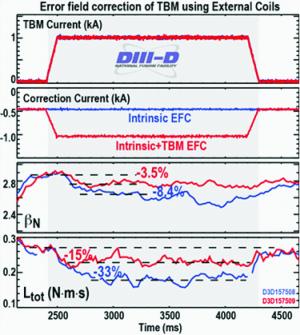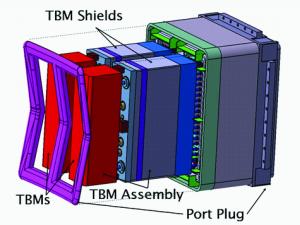High performance operation compatible with test blanket modules
Recent experiments performed by a team of international scientists on the DIII-D tokamak in San Diego, California, USA, indicate that the magnetic field errors introduced by the Test Blanket Modules (TBMs) in ITER can be corrected using non-axisymmetric control coils so that the impact on high performance plasma operation is reduced to a tolerable level.
Present TBM designs for ITER position nearly a ton of ferromagnetic steel close to the plasma surface to test the feasibility and efficiency of producing tritium fuel in the physical structures surrounding the plasma itself. Tritium will be produced within ITER's TBMs by exploiting the neutrons generated by the nuclear reactions occurring in the plasma, which will interact with lithium inside the TBMs.
The latest experiments used sets of both internal and external control coils to correct the magnetic field errors introduced by the TBM mockup in DIII-D. Sophisticated methods of scanning the magnetic fields produced by the correction coils allowed the optimum correction to be made to specific components of the error field.
With the optimum correction fields, it was possible to run the DIII-D plasmas at high performance with almost no degradation in performance due to the TBM mockup. In the graph above, the normalized energy confinement of the plasma (denoted by βN) hardly decreases with optimized error field corrections, though a more sensitive measure of the effects of error fields—the total angular momentum of the plasma—drops by about 15 percent when a single row of external coils is used. Similar results were found using internal correction coils.
The results of these experiments indicate that it should be possible for ITER to compensate for a significant fraction (>60 percent) of the TBM-induced performance degradation in high performance ITER scenarios using either internal or external correction coils. Although a rigorous extrapolation of the DIII-D results to ITER remains to be confirmed, this is very important and timely information for ITER so that the conceptual designs of the TBMs can be finalized before the design reviews of the six test blanket systems begin in July 2014.




